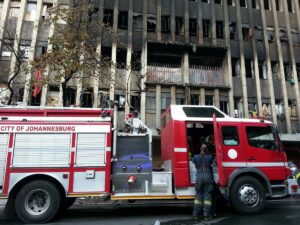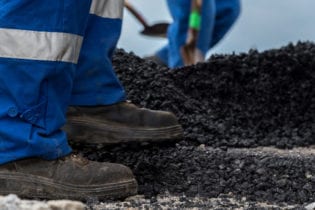The devastating building fire that occurred in August 2023 in the Johannesburg CBD, claiming the lives of 77 indigent people while injuring 88 others, has placed a spotlight on the subject of fire safety.
By SAICE Members Jocelyn Evans and Professor Richard Walls The devastating building fire that occurred in August 2023 in the Johannesburg CBD, claiming the lives of 77 indigent people while injuring 88 others, has placed a spotlight on the subject of fire safety. Billed as one of the deadliest fires in South Africa’s history, chairperson of the South African Institution of Civil Engineering’s (SAICE) Fire Engineering division Jocelyn Evans and SAICE member Professor Richard Walls reflect on the complex issues surrounding fire safety regulatory compliance in public buildings. The right to a safe built environment is embodied in the Constitution, which is supported by the National Building Regulations (NBR). Compliance with the NBR can be attained through a prescriptive approach, utilising SANS 10400, depending on the facility type. For certain facilities, a performance-based – referred to as rational design in South Africa – is necessary. This approach demands quantitative confirmation that the design meets the performance criteria essential for adhering to the functional requirements of the NBR. If the NBR had been honoured in the buildings of recent events, then notification of the event (e.g. an alarm), adequate opportunity to evacuate (e.g. open stairwells) as well as means to limit fire spread (e.g. compartmentalisation) would have resulted in a very different outcome. A high-rise informal settlement is not contemplated in any regulations and within the economic/operational/social constraints could never meet the intentions of the NBR. As such, there is no occupancy classification for this – the reality is that this is an abuse of occupancy as conceived with Part A of the NBR. The City of Johannesburg’s EMS Bylaws regarding vacant buildings state clearly under the Barricading of Buildings subsection: That every owner or person in charge of a building or portion of a building that is vacant must at his or her own cost and to the satisfaction of the Chief Fire Officer – a) Remove all combustible waste and refuse from the building: and b) Block, barricade or otherwise secure all windows, doors and other openings in the building in a manner that will prevent the creation of any fire hazard caused by entering of the building by any unauthorised person.It is clear that the responsibility of enforcing these requirements lies with the owner, according to the NBR and local bylaws, with certain exceptions detailed in the Building Standards Act 103 of 1977.
High rise buildings must not become informal settlements While the investigation into the Johannesburg fire is still on-going, one hopes that the results and recommendations will provide guidance to prevent such disasters from happening again. Fire safety is an important component of modern cities, especially where population density is high. Ultimately, it is not possible for high-rise buildings to effectively become informal settlements and for them ever to be safe. Local authorities need to be empowered [through capacity and competence] to safely engage with any building and owner, including hijacked buildings. The possible implementation of a public reporting system, where dangerous activities can be reported could assist in closing the gap between the owner’s responsibility to engage the local authority, and the local authority’s capacity to perform unprompted (by owner) inspections. Again, this would require the local authority to have adequate capacity to deal with the influx of reports of concerns. SAICE can play a role Supporting government institutions tasked with enforcing the regulatory controls with measures, such as education and skills development, are all aimed at building technical competence throughout the local authority to enable effective accountability to be maintained prior to these events. SAICE’s members have been actively supporting code development on various committees and are developing training materials. SAICE will soon be presenting guidelines to the fire chiefs across the Western Cape regarding fire safety at informal settlements, working with the insurance industry. In collaboration with the South African Institution of Mechanical Engineering, SAICE is also engaging government departments on fire specifications for state buildings. Furthermore, members are assisting the Engineering Council of South Africa to develop accreditation systems for developing competencies. There is no quick fix to the massive problem faced, and a multi-party approach is required to enhance fire safety.






